Cottonwood Stag Beetles - Lucanus mazama
Watching and photographing Cottonwood Stag Beetles (*Lucanus mazama*) in Southwestern Colorado
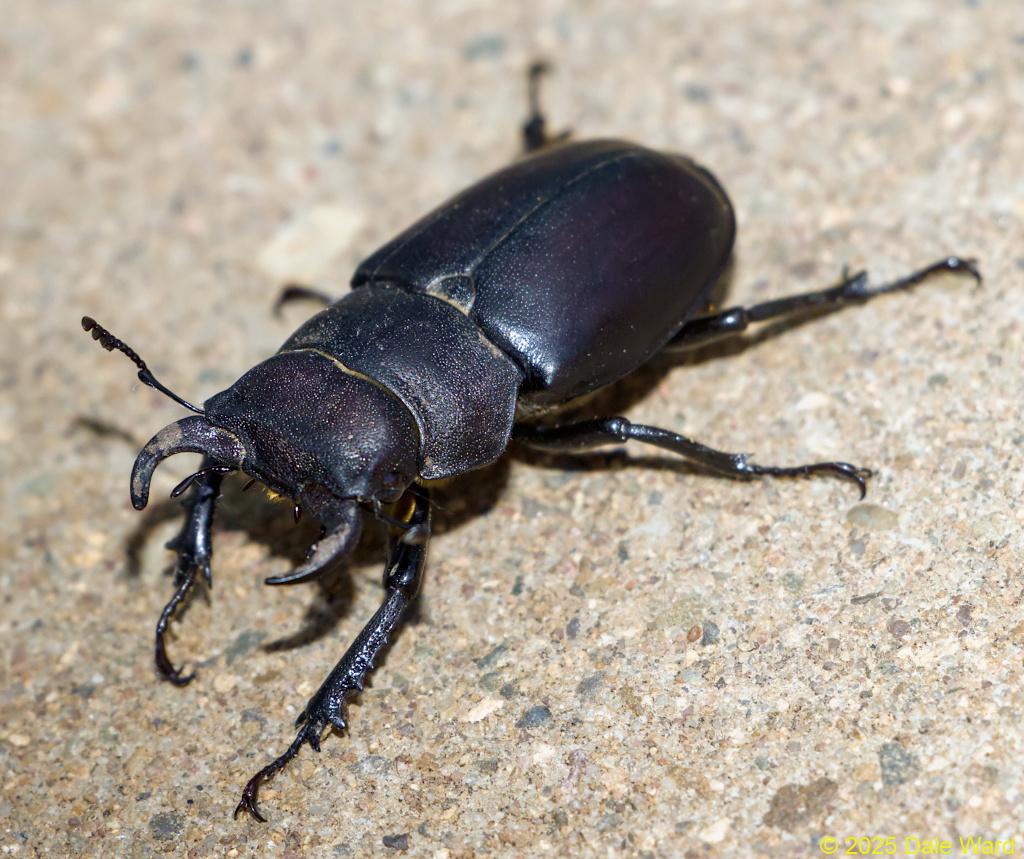 Cottonwood Stag Beetle, posing on our patio.
Cottonwood Stag Beetle, posing on our patio.
Here’s one of our Summertime treats - it’s a Cottonwood Stag Beetles (Lucanus mazama).
We live in Southwestern Colorado, at an elevation of about 6200 feet. If we’ve had good monsoon rains, we’ll frequently find one these spectacular beetles out on the back porch in late July or early August.
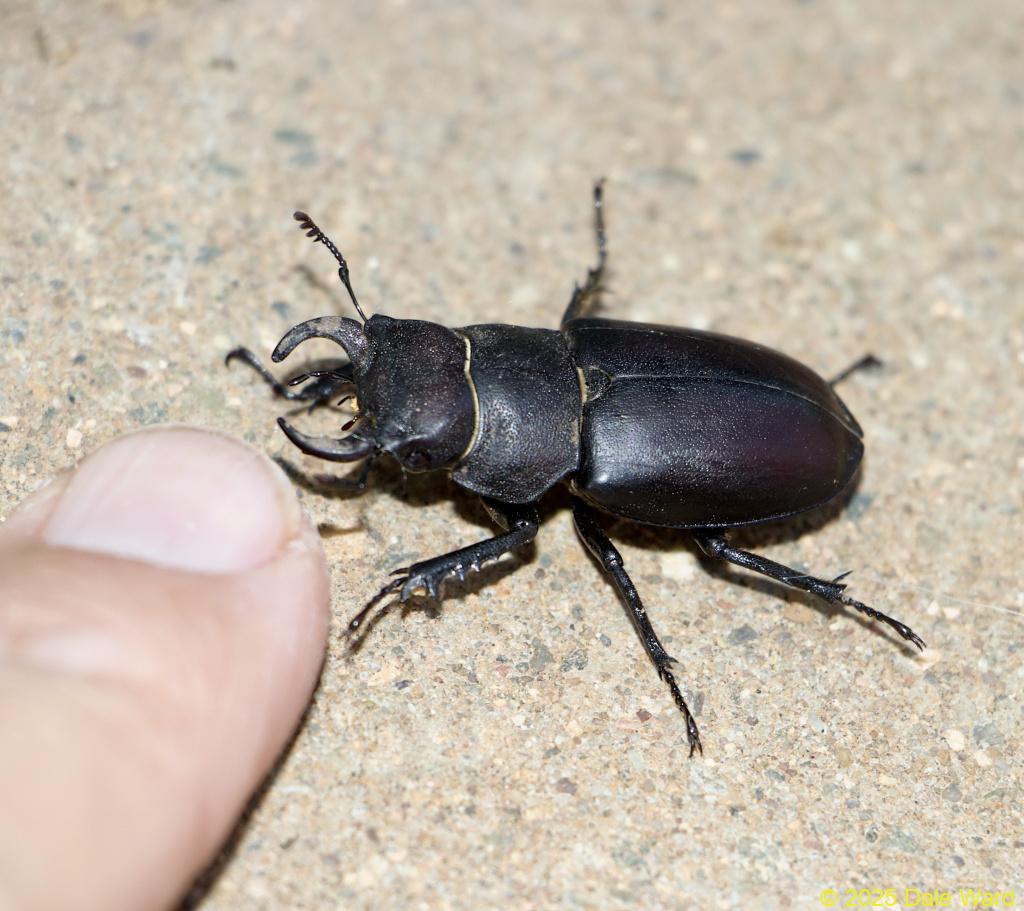 Cottonwood Stag Beetle on our patio, with my finger for scale.
Cottonwood Stag Beetle on our patio, with my finger for scale.
They are quite large - sometimes around two inches long. The males have large, curved mandibles. They use these for ritualized fights with other males. The females look very similar, but they have smaller and more “practical looking” mandibles.
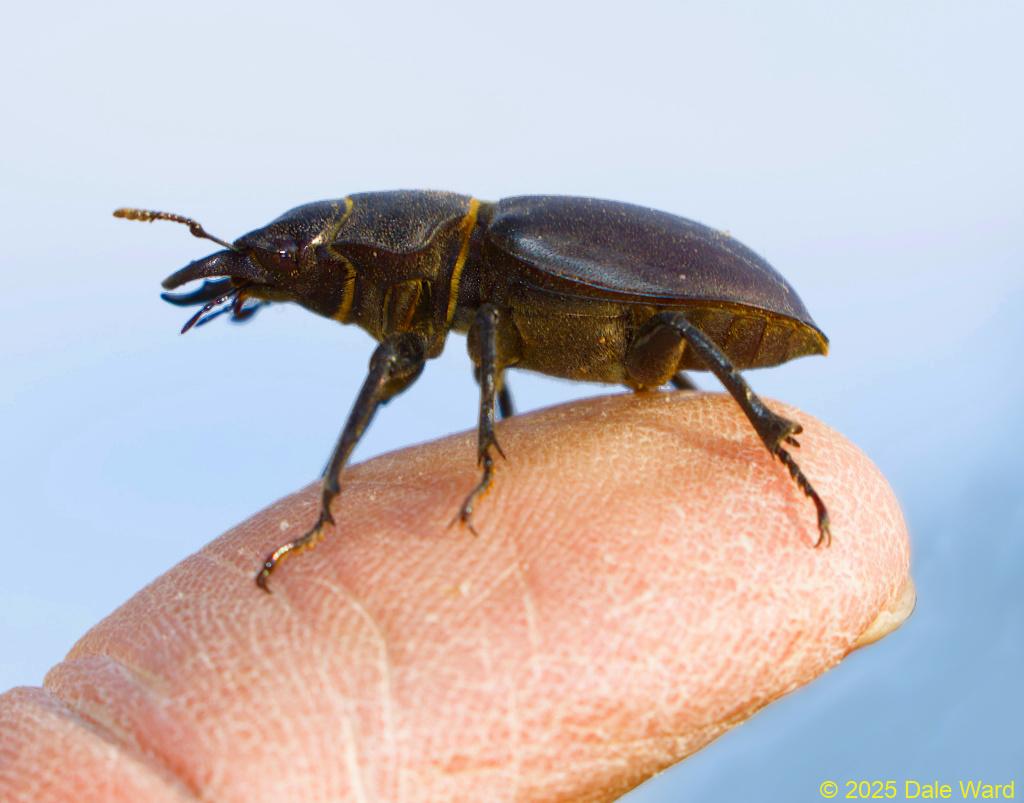 Male Cottonwood Stag Beetle (Lucanus mazana) posing on my thumb.
Male Cottonwood Stag Beetle (Lucanus mazana) posing on my thumb.
When I’ve found these guys, I’ve been struck by how impassive they are. They take on a stiff posture, usually with their mandibles gaping.
They don’t struggle when I pick them up, and they’ll usually remain motionless after I put them back down. After a minute or two, they’ll slowly clamber away.
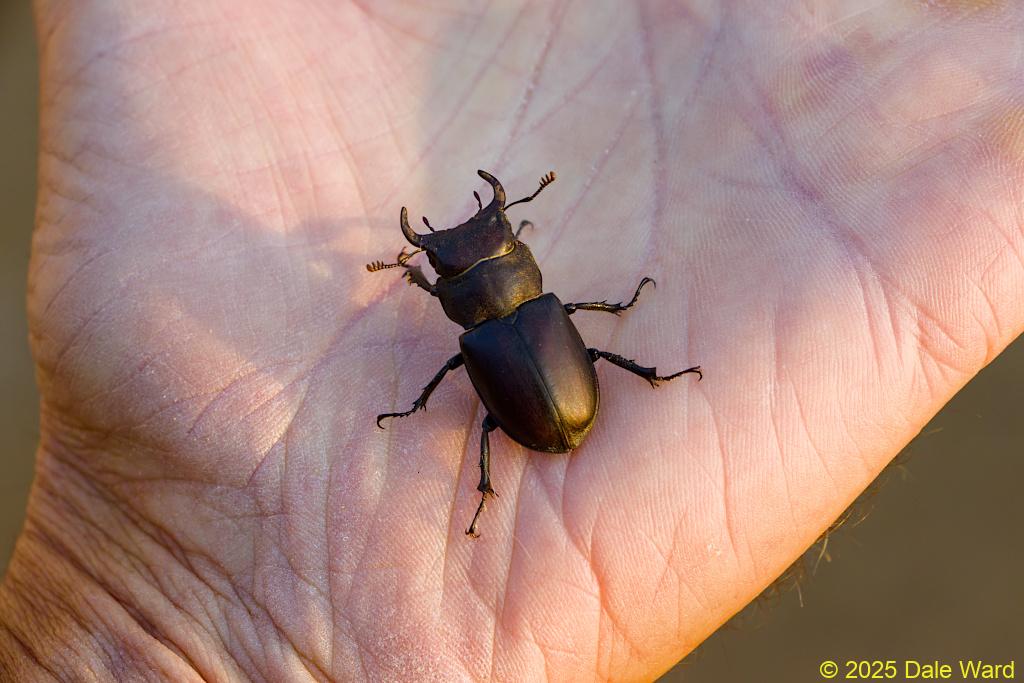 Male Cottonwood Stag Beetle on the palm of my hand.
Male Cottonwood Stag Beetle on the palm of my hand.
Cottonwood Stag Beetles can fly, as unlikely as they might seem. I think we see them on the back porch because they’re flying in to our house lights.
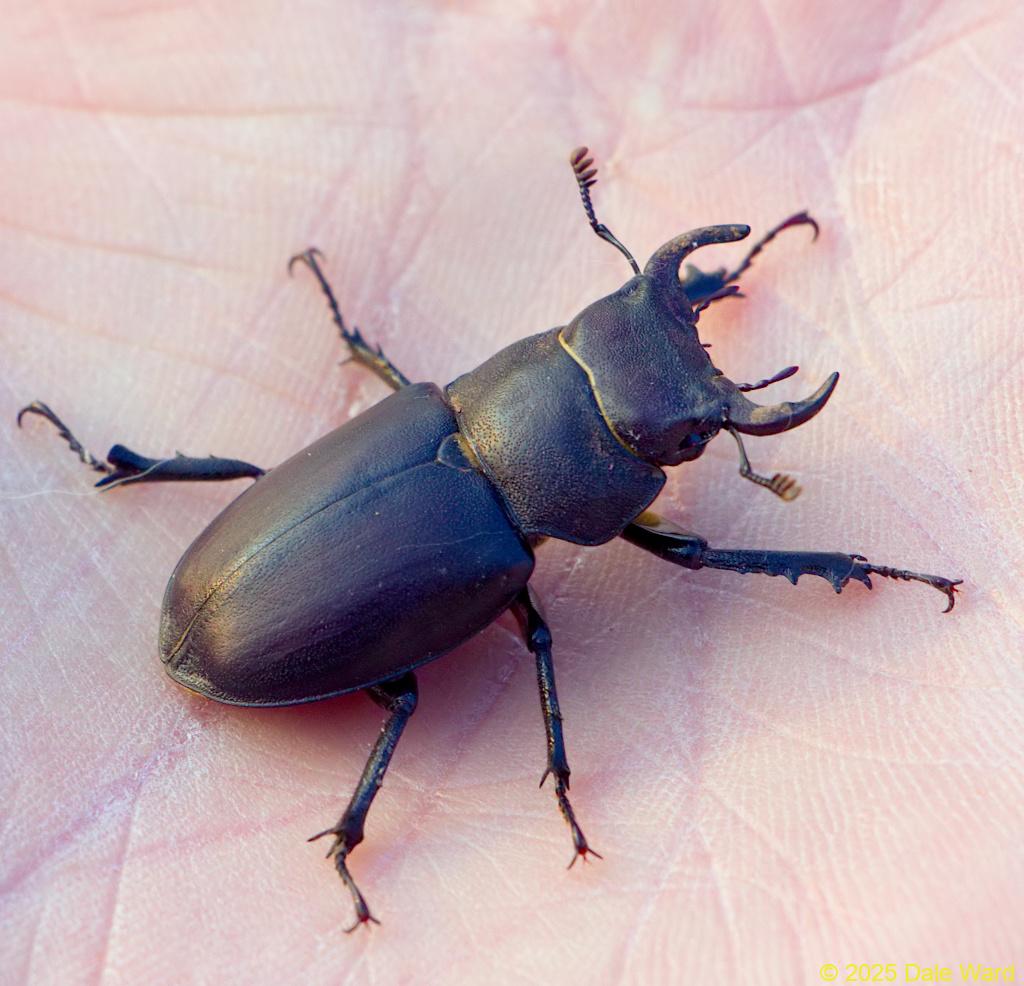 Male Cottonwood Stag Beetle on the palm of my hand. The beetle’s mandibles are noticeably asymmetric. I’m not sure whether or not this is a developmental anomaly.
Male Cottonwood Stag Beetle on the palm of my hand. The beetle’s mandibles are noticeably asymmetric. I’m not sure whether or not this is a developmental anomaly.
They spend most of their lives as grubs, feeding on moist, decaying wood - usually Cottonwood. We’ve got a lot of downed Cottonwood limbs and stumps nearby, so I suspect that’s where they are breeding.
I’ve read that people find the grubs commonly in the wood-chip mulch around children’s playgrounds.
A really nice thing about looking at these beetles is that their large size makes it easy to see details on them- the sculpturing of their exoskeletons, the strange shapes and features of their bodies.
It feels as though you’re looking at them through a microscope, even if you’re looking at them with your unaided vision.
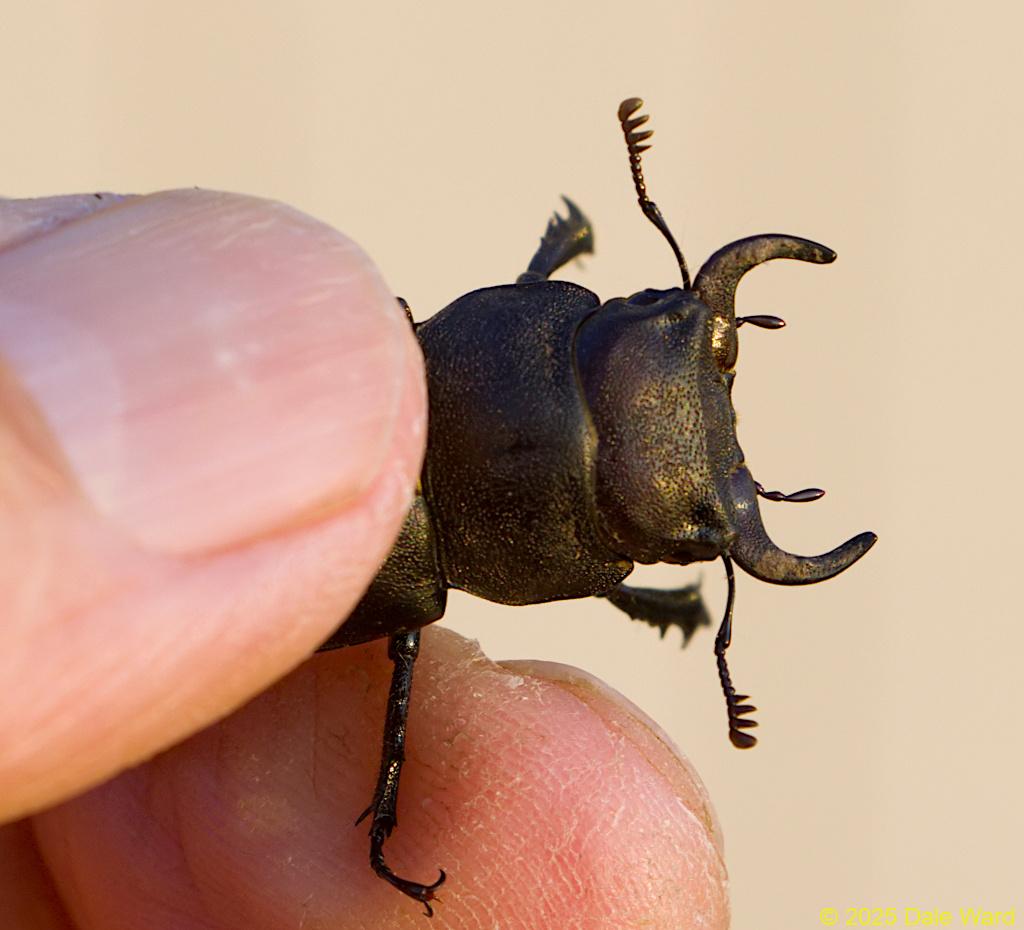 Dorsal view of a male Cottonwood Stag Beetle.
Dorsal view of a male Cottonwood Stag Beetle.
They have beautiful “combs” on the ends of their antennae. And since they don’t wave their antennae around very much, it’s easy to get a good look at them. Again…looking at these beetles is like having “microsope eyes”.
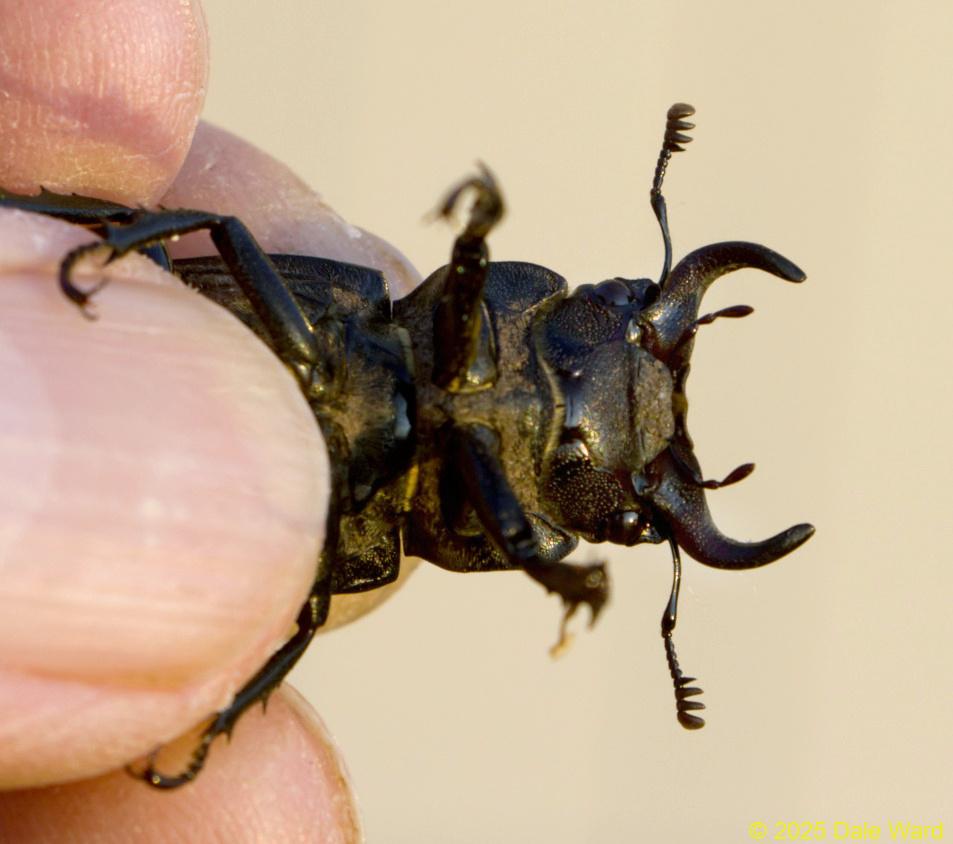 Ventral view of a male Cottonwood Stag Beetle.
Ventral view of a male Cottonwood Stag Beetle.
The adult Stag Beetles can’t eat solid foods. They eat liquids - fruit fluids, saps. The larvae eat dead and rotting wood, digesting with the help of gut bacterial symbionts.
A fascinating thing about Stag Beetle grubs: many species make noise. They have tooth-and-file organs (“stridulatory organs”) on their last two pairs of legs. They can scrape their middle and hind legs back and forth, making making a scraping or ratcheting noise. Different species of Stag Beetles make different noises. The grubs seem to make the noise when they’re upset - if a predator picks them up, for example.
But they also make the stridulatory noise when they are annoyed. Dr. Eva Sprecher-Uebersax describes watching a dispute between two Stag Beetle grubs one of whom was encroaching upon the other’s pupal chamber. The offended grub stridulated and head-butted the trespasser until it left.
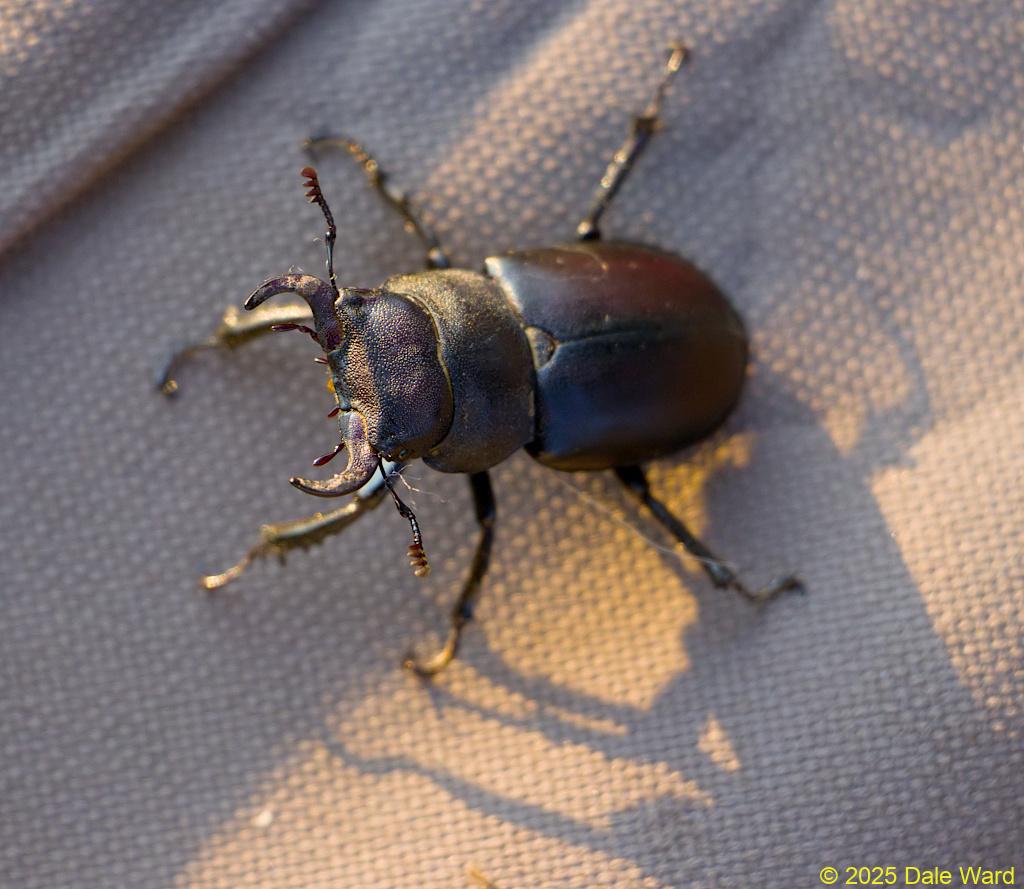 Male Cottonwood Stag Beetle posing in the morning sunlight.
Male Cottonwood Stag Beetle posing in the morning sunlight.
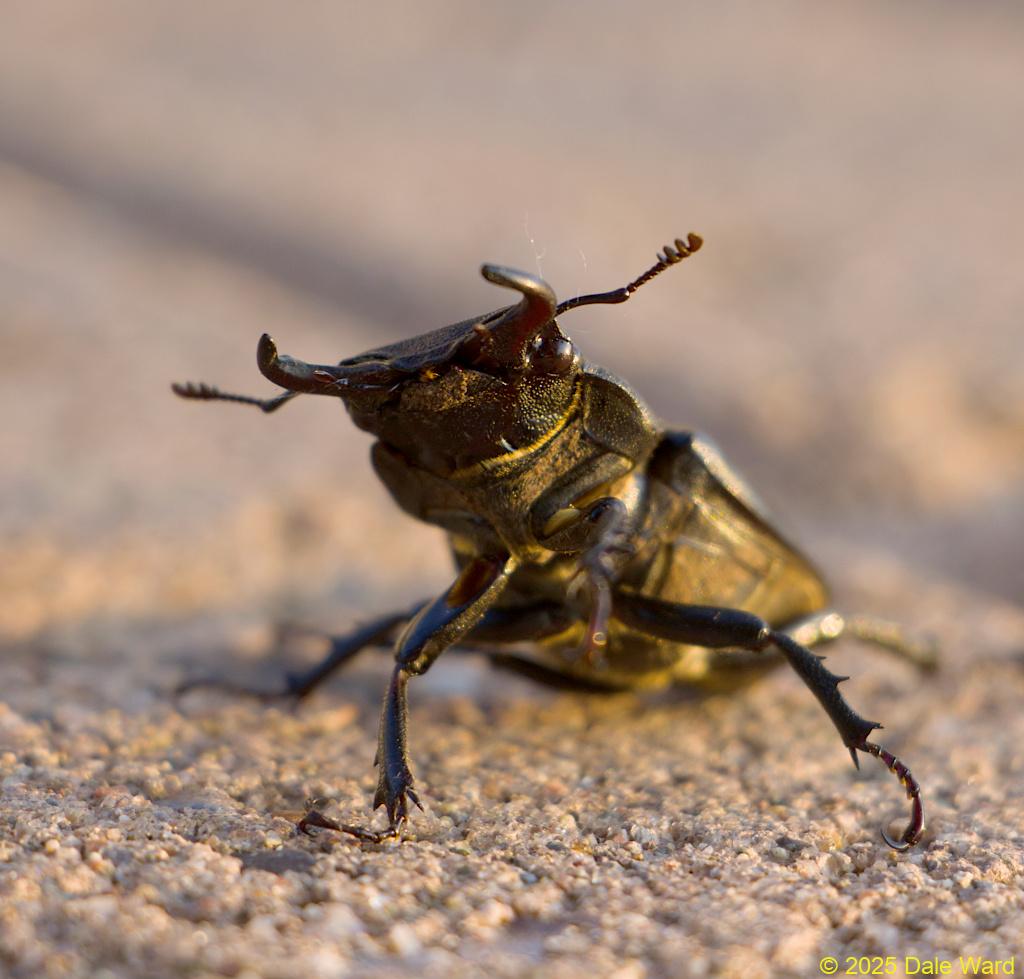 Male Cottonwood Stag Beetle posing in the morning sunlight.
Male Cottonwood Stag Beetle posing in the morning sunlight.
When I was searching for information on Cottonwood Stag Beetles, I kept finding sites that were selling them. I was astonished to find that Cottonwood Stags are part of the pet trade. Some sites were selling grubs, others were selling live adults. Some wild-caught, some captive-bred.
I guess I’m pretty lucky, living in a place where I can see things like these by just being out-and-about.
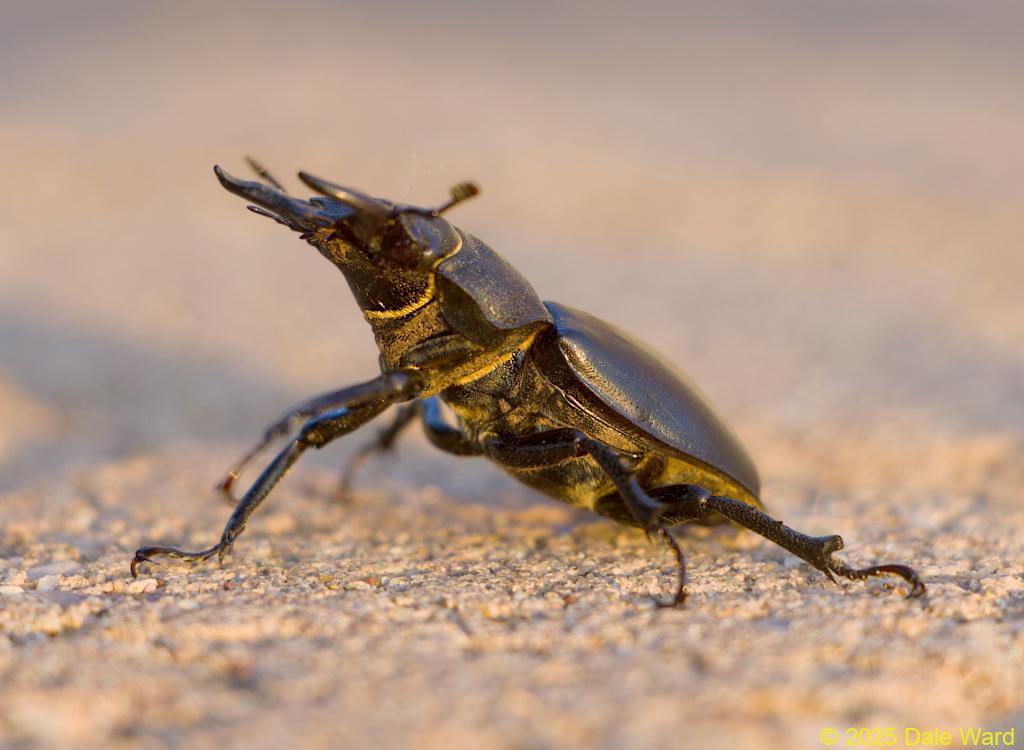 Side view of a male Cottonwood Stag Beetle (_Lucanus mazana_). You can see the light-colored bands of hair around the beetle’s thorax.
Side view of a male Cottonwood Stag Beetle (_Lucanus mazana_). You can see the light-colored bands of hair around the beetle’s thorax.
Those bands of blonde color between the plates of their exoskeleton are hairs. I think these are mostly proprioceptive - they are a way for the beetle to feel the position of his body.
Imagine having to go through the world wearing a suit of armor, only able to feel the world via sensory hairs.
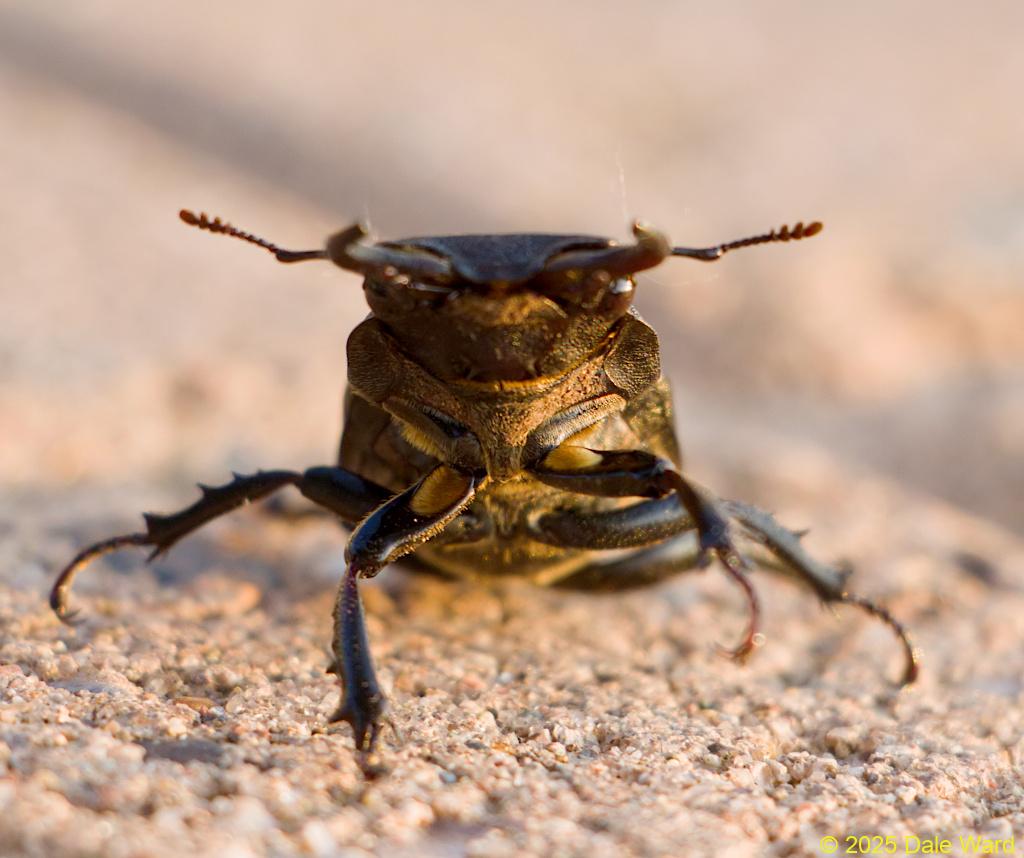 Male Cottonwood Stag Beetle posing in the morning sunlight. You can see two light patches at the base of his front legs.
Male Cottonwood Stag Beetle posing in the morning sunlight. You can see two light patches at the base of his front legs.
One of the things people notice about the Stag Beetles are the light patches at the base of their front legs. The patches are mostly noticeable when you look at the beetle from the front - you can see them in the photo above.
These light patches are comprised of hairs - here’s a close-up of one of them:
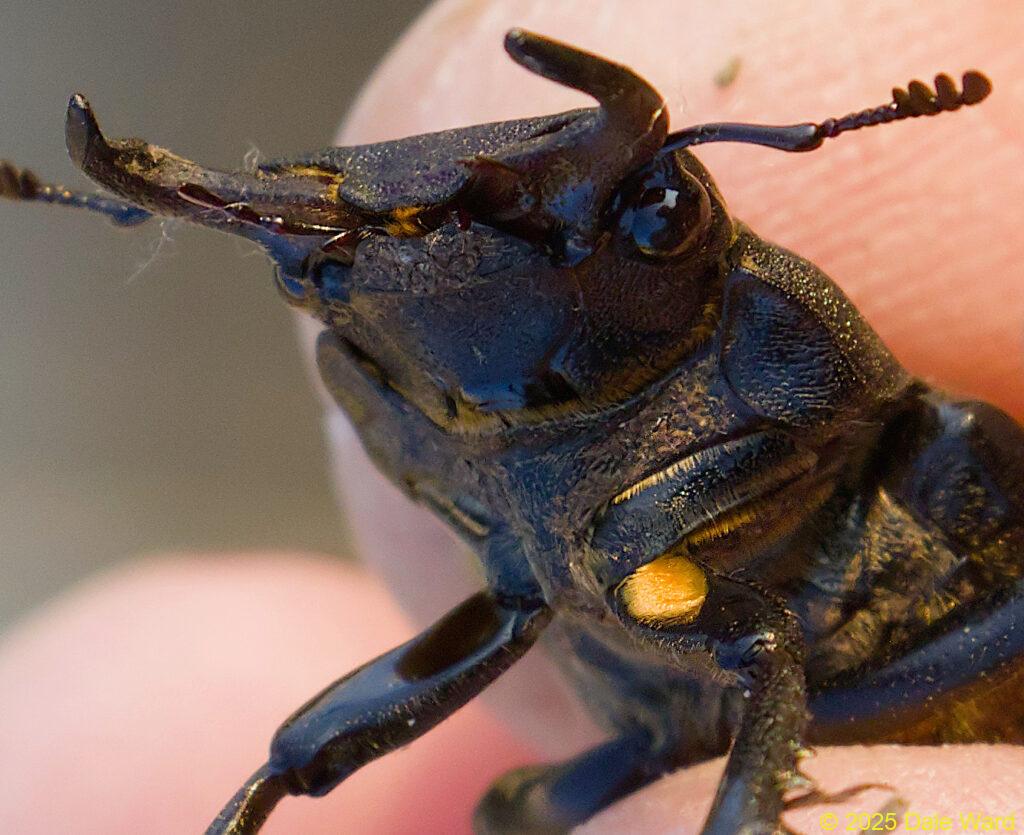 Closer view of a Cottonwood Stag Beetle (_Lucanus mazana_), held in my fingers. You can see the large yellow-orange circle on his leg a pad of hair. My assumption is that these are proprioceptive, they help the beetle sense the position of its front legs.
Closer view of a Cottonwood Stag Beetle (_Lucanus mazana_), held in my fingers. You can see the large yellow-orange circle on his leg a pad of hair. My assumption is that these are proprioceptive, they help the beetle sense the position of its front legs.
I think these are “hair plates” - pads of sensory hairs. There’s a prominent exoskeletal ridge that partially covers the plates - you can see in in the photo above. That ridge would probably rub along the hair plate as the beetle moves. I’ll bet that the hair plates let them know exactly where their front legs are, especially how precisely far forward they’ve extended their legs.
I wonder if the sensory information from these hair patches is especially important because of the way male Stag Beetles duel with their mandibles.
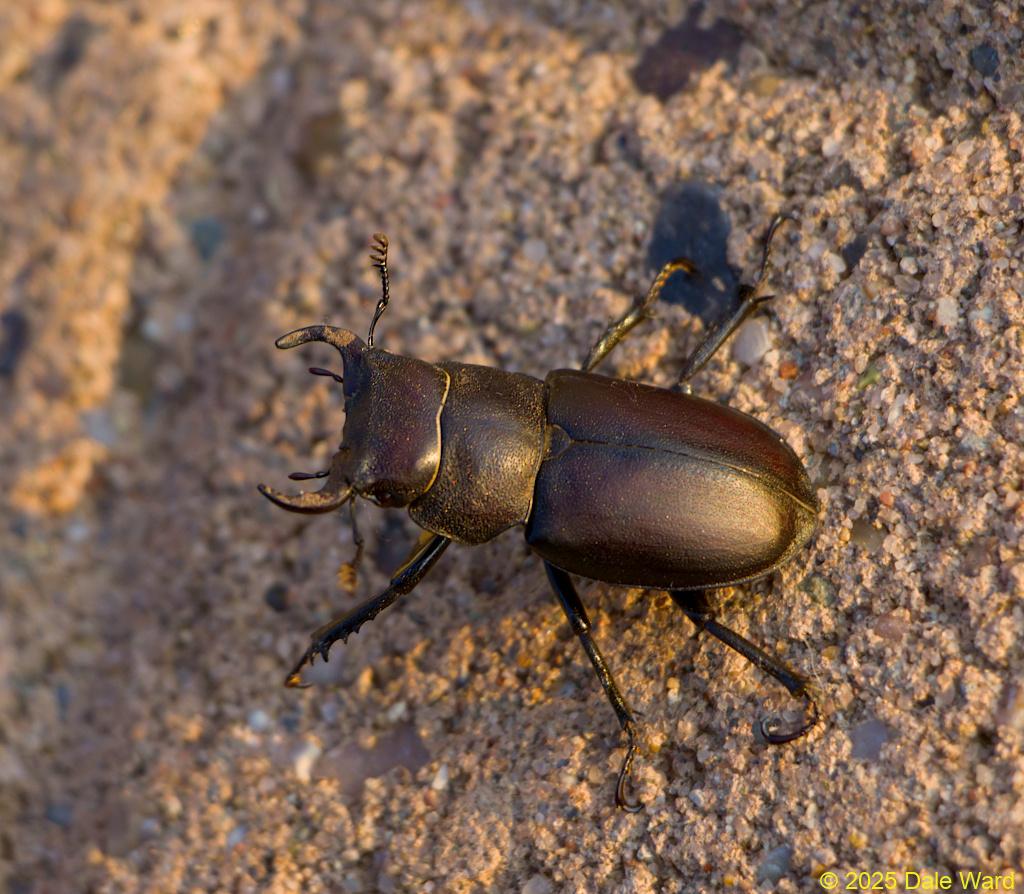 Male Cottonwood Stag Beetle (Lucanus mazana).
Male Cottonwood Stag Beetle (Lucanus mazana).
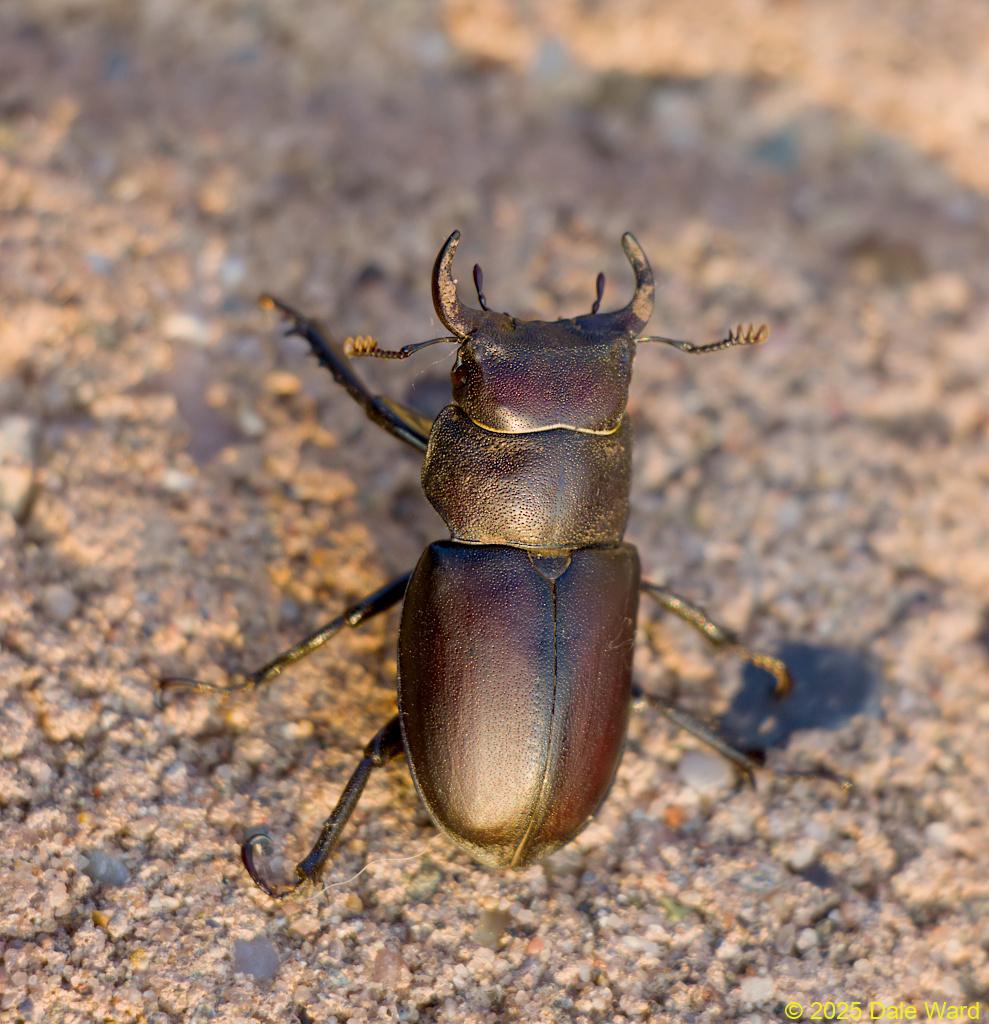 Male Cottonwood Stag Beetle (Lucanus mazana).
Male Cottonwood Stag Beetle (Lucanus mazana).
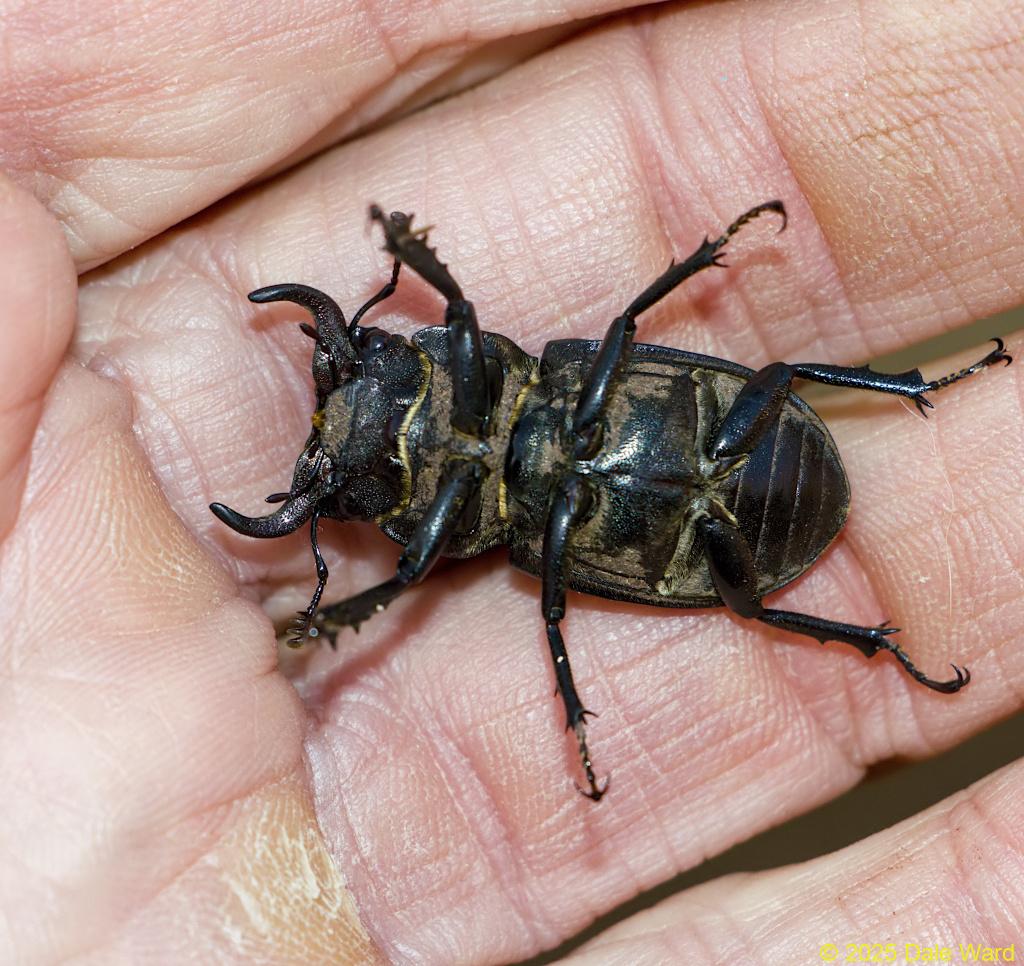 Ventral view of a male Cottonwood Stag Beetle (Lucanus mazana) in the palm of my hand. Lots of grit and dried mud on him.
Ventral view of a male Cottonwood Stag Beetle (Lucanus mazana) in the palm of my hand. Lots of grit and dried mud on him.
When I find these beetles, a lot of the time they will have patches of dried mud and grit on them, almost as though they had been painted with clay.
I’m guessing that the dried mud and grit are left from digging themselves out of the soil, perhaps after they have morphed into adults and emerge from their pupal cases.
I wonder what that’s like for them, working their way out of the husk of their chrysalis, clawing their way up through the mud into the light, into a world that is violent, loud, and glaring.
Every time I see them I think of a scene in the television show “Buffy the Vampire Slayer”. Buffy has just clawed her way out of her grave. Her hands are dirty and bloodied, and she is staggering around in daze, not sure what to make of the noise and violence of the world, and her friends are looking at her hands:
Dawn Summers: [of Buffy’s bloodied hands] Um, I was gonna fix ‘em… I don’t know how they got like that.
Spike: I do. Clawed her way out of a coffin, that’s how. Isn’t that right?
Buffy Summers: Yeah… That’s what I had to do.
Spike: I’ve done it myself.
Yes, I know it’s not really applicable, and that by writing that, I’m exposing myself as a big non-scientific geek.
But still - that’s what runs through my mind when I see the beetles staggering in the light, dried mud still on them.
Sources:
Evans, Arthur V. 2021. Beetles of Western North America. Princeton University Press (September 28, 2021). ISBN 0691164282.
Marshall, Stephen A. 2018. Beetles: The Natural History and Diversity of Coleoptera. Firefly Books; Illustrated Edition (September 1, 2018). ISBN 0228100690.
Dong, Xu-ming and Lu Jiang. 2024. Species-specific larval acoustic behaviour of three stag beetles (Coleoptera: Lucanidae), with emphasis on their stridulatory organs and acoustic signals. Arthropod Structure and Development. Vol. 80. May 2024.
Dr. Maria Sprecher-Uebersax has some lovely photos and information on _Lucanus cervus_, a European Stag Beetle. She’s got really nice photos and accounts of the grubs’ stridulating here: https://maria.fremlin.de/stagbeetles/larva.html#stridulation
The Internet Movie Database, for their quotation from Buffy the Vampire Slayer. It’s from Season 6, Episode 3 - “After Life”.
Pat Otto’s “Good Natured” blog post on Stag Beetles - here: https://www.stcnature.org/good-natured/stag-beetles-2/. I think Pat is talking mostly about the Giant Stag Beetle, Lucanus elaphus. It is even more spectacular, morphologically, than our Cottonwood Stag Beetle, with huge, antler-like mandibles. But it’s such a well-written and informative post, it’s hard not to mention.
As always, seemingly, many, many thanks to Bugguide.net.